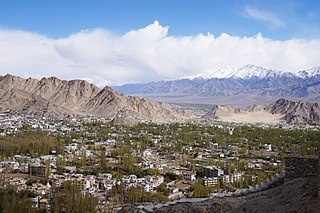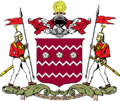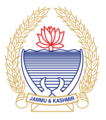
Jammu and Kashmir was a region formerly administered by India as a state from 1952 to 2019, constituting the southern and southeastern portion of the larger Kashmir region, which has been the subject of a dispute between India, Pakistan and China since the mid-20th century. The underlying region of this state were parts of the former princely state of Jammu and Kashmir, whose western districts, now known as Azad Kashmir, and northern territories, now known as Gilgit-Baltistan, are administered by Pakistan. The Aksai Chin region in the east, bordering Tibet, has been under Chinese control since 1962.

India is a federal union comprising 28 states and 8 union territories, with a total of 36 entities. The states and union territories are further subdivided into districts and smaller administrative divisions.

The Gilgit Agency was an agency of the British Indian Empire consisting of the subsidiary states of the princely state of Jammu and Kashmir at its northern periphery, mainly with the objective of strengthening these territories against Russian encroachment. The subsidiary states included Hunza, Nagar and other states in the present day districts of Gupis-Yasin, Ghizer, Darel, Tangir and Diamer. The agency headquarters was based in the town of Gilgit, which was itself under the direct administration of the Maharaja of Jammu and Kashmir.

The High Court of Jammu & Kashmir and Ladakh is the common High Court for union territories of Jammu and Kashmir and Ladakh. It was established as the High Court of Jammu and Kashmir on 26 March 1928 by the Maharaja of Jammu and Kashmir. The seat of the court shifts between the summer capital Srinagar and winter capital Jammu. The court has a sanctioned judge strength of 17, 13 of whom are permanent judges, and 4 are additional judges. Since 13 October 2022, the Chief Justice of the Court is Hon'ble Shri Justice Ali Mohammad Magrey.

Article 370 of the Indian constitution gave special status to Jammu and Kashmir, a region located in the northern part of Indian subcontinent and part of the larger region of Kashmir which has been the subject of a dispute between India, Pakistan and China since 1947. Jammu and Kashmir was administered by India as a state from 1952 to 31 October 2019, and Article 370 conferred on it the power to have a separate constitution, a state flag, and autonomy of internal administration.

Leh district is a district in the union territory of Ladakh, India. With an area of 45,110 km2, it is the second largest district in the country smaller only to Kutch. It is bounded on the north by Gilgit-Baltistan's Kharmang and Ghanche districts and Xinjiang's Kashgar Prefecture and Hotan Prefecture linked via the historic Karakoram Pass. It has Aksai Chin and Tibet are to the east, Kargil district to the west, and Lahul and Spiti to the south. The district headquarters is in Leh. It lies between 32 to 36 degree north latitude and 75 to 80 degree east longitude.
Jammu & Kashmir Bank Limited is an Indian public sector bank headquartered in Srinagar, Jammu and Kashmir. J&K Bank was incorporated on October 1, 1938, by then ruler of princely state of Jammu and Kashmir Maharaja Hari Singh with initial paid up capital of ₹ 5.00 Lakh. The bank registered a total business turnover of over Rs.1750 billion as on March 31, 2021.

The Government of Jammu and Kashmir is the governing authority of Jammu and Kashmir and its two divisions and 20 districts. Jammu and Kashmir is a union territory under the terms of Article 239A of the Constitution of India. Jammu and Kashmir has executive, legislative and judicial branches of government. Srinagar and Jammu are the summer and winter capitals of Jammu and Kashmir respectively.
The Jammu and Kashmir Legislative Assembly also known as the Jammu and Kashmir Vidhan Sabha is the legislature of Indian union territory of Jammu and Kashmir.

The State flag of Jammu and Kashmir was a symbol used in the former Indian state of Jammu and Kashmir between 1952 and 2019, under the special status accorded to the region by Article 370 of the Constitution of India. It was a red-and-white flag with a representation of a plough and three constituent regions of the state. After the abolition of Article 370 in August 2019, this flag lost its official status.

Girish Chandra Murmu is the 14th Comptroller and Auditor General of India and the external auditor of the Inter-Parliamentary Union. He is also the chairman of the United Nations Panel of External Auditors and the Asian Organization of Supreme Audit Institutions. He is currently the external auditor of the WHO (2020-2023), succeeding the Auditor General of the Philippines. He was the Inaugural Lieutenant Governor of the Union Territory of Jammu and Kashmir till 6 August 2020. He is a 1985 batch IAS officer of Gujarat cadre and was principal secretary to Narendra Modi during his tenure as the Chief Minister of Gujarat.

The following outline is provided as an overview of and topical guide to Jammu and Kashmir:

Jammu and Kashmir is a region administered by India as a union territory and consists of the southern portion of the larger Kashmir region, which has been the subject of a dispute between India and Pakistan since 1947, and between India and China since 1962. The Line of Control separates Jammu and Kashmir from the Pakistani-administered territories of Azad Kashmir and Gilgit-Baltistan in the west and north. It lies to the north of the Indian states of Himachal Pradesh and Punjab and to the west of Ladakh, which is also subject to the dispute as a part of Kashmir, and administered by India as a union territory.
The Jammu and Kashmir Reorganisation Act, 2019 is an act of the parliament of India containing provisions to reconstitute the Indian-administered state of Jammu and Kashmir, a part of the larger region of Kashmir which has been the subject of dispute among India, Pakistan, and China since 1947, into two Indian-administered union territories (UTs) called Jammu and Kashmir, and Ladakh, and becoming effective on 31 October 2019. A bill for the act was introduced by the Minister of Home Affairs, Amit Shah, in the Rajya Sabha on 5 August 2019 and was passed on the same day. It was then passed by the Lok Sabha on 6 August 2019 and it received the president's assent on 9 August 2019.

The Administration of Union Territory of Ladakh(sic) is the governing authority of the Indian union territory of Ladakh and its two districts. The Administration is led by a Lieutenant Governor appointed by the President of India who acts on behalf of the central Government of India. Ladakh does not have an elected legislative assembly. The two districts of Ladakh both elect their own autonomous district council-the Leh Autonomous Hill development council and the Kargil Autonomous Hill development Council, which have competence over a range of domestic affairs.



















